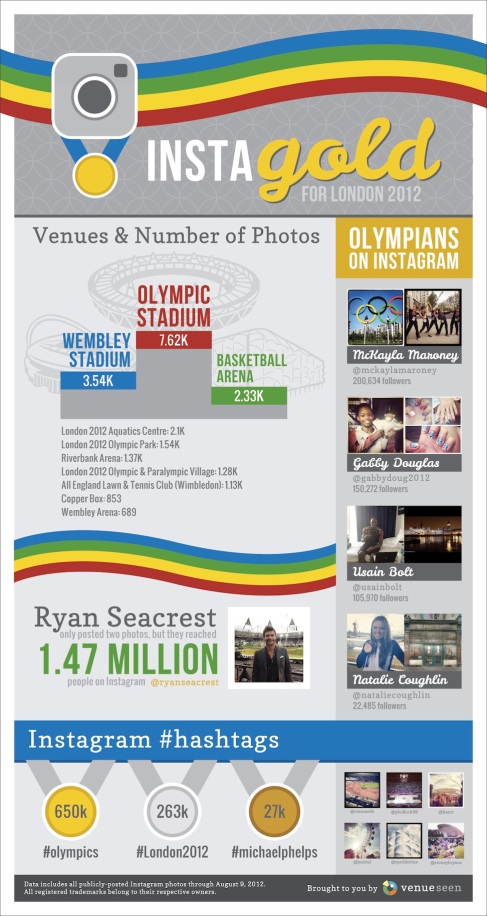(This blog post has also been posted on AU MA Social Media blog.)
During the 2012 Summer Olympics, millions of photos have been shared via Instagram. The popular mobile app got 50 million registers at the end of this April, increased three times when it started with just 15 million users. According to data released on the July, Instagram gained more than 80 million users and 4 billion photos. Now, after the Olympic Games, Instagram probably will get more subscribed users.
Let’s look at what Instagram achieved during the game. According to VenueSeen, 650,000 photos have been uploaded with hashtag #Olympics; 263,000 photos has been uploaded with hashtag #london 2012. The most popular venue people used Instagram is Olympic Stadium; the next one is Wembley Stadium, the Olympic soccer spot, following with the Basketball Arena.
IOC enacted series of restrictions on this game. Athletes and other accredited persons are encouraged to do personal posts on social media channels in a first-person, diary-type format.. But they cannot post during competitions, cannot shot videos. Spectators are allowed to take photos and videos, but not allowed to post any video.
Here is one example. “Participants and other accredited persons can post still photographs taken within Olympic Venues for personal use. It is not permitted to commercialise, sell or otherwise distribute
these photographs.”
It seems like that IOC and TV networks, however, can do nothing with the popularity of the social media. During the game, spectators use this popular app to share their favorite snaps, journalists use it to report. After the game, the teams and individual participants use it to celebrate their victories. The whole world can see another side of Olympic via athletes phones.
Apart from the data listed above, the obvious evidence can be 27,000 photos shared with the #michaelphelps hashtag, 650,000 photos have been posted with the #olympics hashtag, while more than 263,000 have been uploaded with the #london2012 hashtag.
Taking Olympic game as a transcendent experience, instagram will maintain popular in the future competitions, meetings, and other public activities. Based on the effect of social media tool like instagram, Olympic game is becoming increasingly democratic and publicly. Who will be the next? How can we take advantage of the social media tools in the future sports game? Allowing such social media tools in other sport competitions like MLB or NHL brings the competition itself positive or negative one? These questions should be publicly discussed in the future.
(Infographic on the use of instagram of Olympic game)
Resource:
1. Instagram Passes 50 Million Users, Adds 5 million a week
http://mashable.com/2012/04/30/instagram-50-million-users/
2. How Instagram is Winning Gold at the 2012 Olympics
http://mashable.com/2012/08/11/instagram-olympics-infographic/
3. Terms and Conditions of Ticket Purchase
http://www.tickets.london2012.com/purchaseterms.html
4. IOC Social Media, Blogging and Internet Guidelines for participants
and other accredited persons at the London 2012 Olympic Games
http://www.olympic.org/Documents/Games_London_2012/IOC_Social_Media_Blogging_and_Internet_Guidelines-London.pdf
5. London Olympics: How the IOC Controls Social Media
http://www.mobiledia.com/news/157205.html
 As a playful and also mindful documentary director, Morgan Spurlock always immersed himself into “seemingly horrible situations” to engage and entertain his audience. Lived in the prison, worked in copper mine, and ate only burgers for three month. As if that is not enough, now he wants to do something challenging, a quirky but meaningful film, to engage audience and to inspire thoughts.
As a playful and also mindful documentary director, Morgan Spurlock always immersed himself into “seemingly horrible situations” to engage and entertain his audience. Lived in the prison, worked in copper mine, and ate only burgers for three month. As if that is not enough, now he wants to do something challenging, a quirky but meaningful film, to engage audience and to inspire thoughts. movie, they just decided to take the risk and let their customers learn the real side of their products and their companies. It was more than what Morgan said that these people were embracing the risk and uncertainty. These companies were trying to be transparent to the customers and to present their sincerity to the audience. They were open to love, criticism, complement and any other sentiment. We must appreciate their sincerity no matter how the final movie will be. I believe with the 17 sincere risk-takers and the courage to break down any pretention but only bring us transparency, it must be one of the greatest movies we ever seen.
movie, they just decided to take the risk and let their customers learn the real side of their products and their companies. It was more than what Morgan said that these people were embracing the risk and uncertainty. These companies were trying to be transparent to the customers and to present their sincerity to the audience. They were open to love, criticism, complement and any other sentiment. We must appreciate their sincerity no matter how the final movie will be. I believe with the 17 sincere risk-takers and the courage to break down any pretention but only bring us transparency, it must be one of the greatest movies we ever seen.